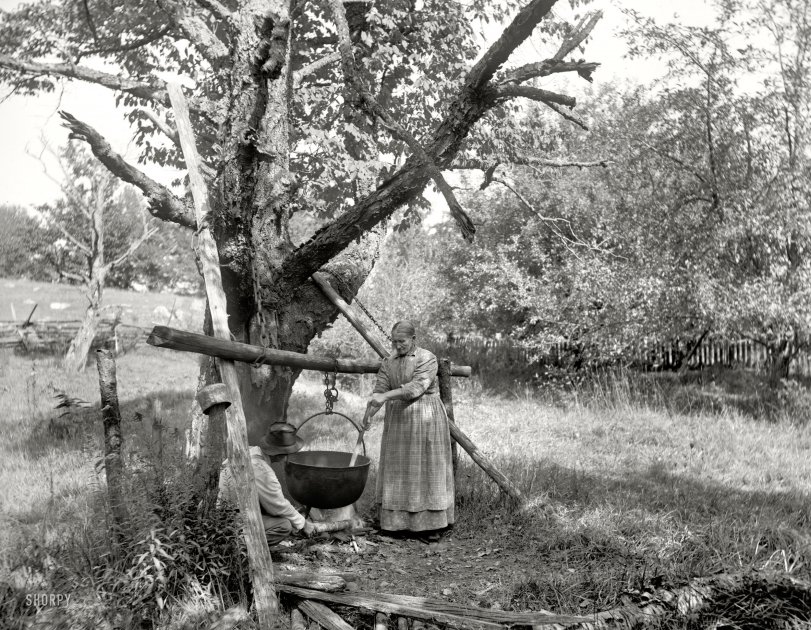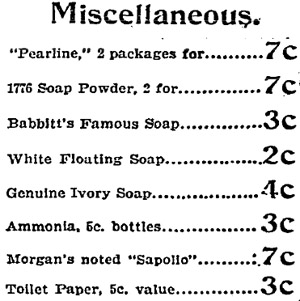


Framed or unframed, desk size to sofa size, printed by us in Arizona and Alabama since 2007. Explore now.
Shorpy is funded by you. Patreon contributors get an ad-free experience.
Learn more.

- Details, Details
- What's that building to the left of the tower?
- Coal Barges
- Bromo-Seltzer
- Inner harbor
- The Basin
- What a headache!
- Giant stepladder?
- Baldwin 62303
- Baldwin VO-1000
- Cold
- No expense spared
- Tough Guys
- Lost in Toyland
- And without gloves
- If I were a blindfolded time traveler
- Smoke Consumer Also Cooks
- Oh that stove!
- Possibly still there?
- What?!?
- $100 Reward
- Freeze Frame
- Texas Flyer wanted
- Just a Year Too Soon
- WWII -- Replacing men with women at the railroad crossing.
- Yes, Icing
- You kids drive me nuts!
- NOT An Easy Job
- I wonder
- Just add window boxes
Print Emporium
Ma Kettle: 1900

Circa 1900. "A bit of country life near Henryville, Pennsylvania -- making soap." 8x10 inch dry plate glass negative, Detroit Publishing Company. View full size.
Mom's experience
A number of years before her death (at 97), I asked Mom to write her account of growing up in rural Ontario without running water or electricity. We ended up with quite an autobiography, including a section on soapmaking.
All the soap used in the Shannon household was home made from materials at hand, fat and potash. The fat came from the pork which was a staple meat. The potash came from wood ashes from the kitchen stove. Near the back door was a round tank about 4 or 5 feet high and whenever the ashes were taken out of the stove they were put in this tank along with some water. When it was time to make the soap, the liquid, now lye or potash, was drained off through a tap at the bottom of the tank.
Now the big iron kettle on the tripod came into service. Measured amounts of fat and potash were put in the pot and a fire was started under the kettle. I remember seeing Grandma Lou stirring the contents of the kettle and imagining she was a witch. Indeed she could have passed for one, long dark clothes, shawl around her head and shoulders, all she lacked was the pointed hat and broomstick.
After several hours of boiling and stirring the soap was finished, the fire allowed to go out and the soap to set. On top would be about 4 inches of lovely white soap which would be cut into bars and used for hands and baths and laundry. Below was about 2 inches of light brown liquid soap, called soft soap. This was put in a bowl beside the wash basin in the woodshed for the workmen (just Grandpa by this time) to get the real grime off.
Below the soft soap was about 1/2 inch of glycerine. This was mixed with rosewater (the only purchased item) to use as a hand lotion to repair the damage done by the soap.
My mother carried on the tradition of soap making on the kitchen stove, but she bought the lye in cans to mix with the fats which she had carefully saved. I do not remember there being soft soap and glycerine as a byproduct.
A "Wida maker"
That's what you call that dead limb hanging up there, at least up here in the northwest, because they often fall on the logger while cutting down a tree, I guess that one would be a "widower maker"!
Danger!
There's a very large, very dead limb hanging directly above her head!
Grandma's Lye Soap
Reminds me of an old song called "It's In The Book", with the following lyrics:
Cousin Herman, and brother Thurman
Had an aversion
To washing their ears
Till Grandma washed them
With her lye soap
Now they haven't heard a word in years!
Hard Soap
The relationship between money and time would have been very different on a small farm, which would have been largely a subsistence operation, with only a little money from selling surplus. Cash was likely reserved for things requiring too much tech to be practical like steel tools and cloth. Extra money required extra time to run something like a few beehives or extra laying chickens to produce something salable.
Lye probably would not have been "gathered" by someone far down the food chain. Lye was made by burning hardwood from a scrubby woodlot and soaking the ashes! Lots of time, no cash. Fat would have been tried out from animals and carefully saved
Granny would have supplied the experience to get the recipe right -- too much lye, and the soap will clean you right down to the bone. Too little and you have grease.
Objects In Glass Plate Appear Closer Than They Are
I think she's standing a good foot or more away from the fire, based on how far out her left forearm would likely reach. Far away things tend to appear closer to each other than they really are and photography captures this illusion.
Making soup.
That's what I thought it said yesterday. Then I thought, man, they sure must have a big family.
Engineering Consultant
Obscure engineer Morris Goldberg (whose son Rube was later to achieve fame as a cartoonist) drew a Free Body Diagram of the beam that's holding up the cauldron. He concluded that additional reinforcement was needed, so he specified the two custom made sizes of iron chains shown.
Well, it worked, didn't it? This photo is the proof. A print was found in Mo's briefcase after he passed on in 1947.
Easy on the lye!
Baby soap has to be mild. Possum fat and lye was Granny Clampett's recipe, I do recall.
Granny Flambe
The hem of her dress is awfully close to the fire. It's making me nervous.
Blaze of Glory
If the hem of Grandma's dress gets any closer to the fire she is going to be all "lit up."
The things we take for granted: Soap
Until I saw this, I never considered the purchase of a bar of soap to be a labor-saving act. It is good that soap is available in our stores since I have no idea of how to make it.
The photo is dated 1900. P&G's Ivory Soap had been available since 1879. Perhaps it was considered an unaffordable luxury by some in 1900 - a necessity in today's world. I suppose underarm deodorant was not even considered.
The things we take for granted.
Price of soap in 1900
I could not find how much a bar of soap cost in 1900, but it had to be a few cents. Compare that to what must be an all day job: gathering the wood, gathering the fat and lye, setting the fire, melting and stirring the ingredients, cooling them, cutting the bars up, stacking them, then cleaning up and putting that cannibal kettle away.
They are doing all that to save how many pennies? Doesn't make sense to brains and wallets 110 years later.

Did they load up the truck
and move to Beverly? Hills, that is.
























On Shorpy:
Today’s Top 5